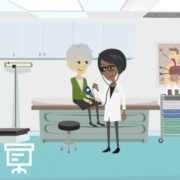How Is DLBCL Treatment Effectiveness Monitored?
How Is DLBCL Treatment Effectiveness Monitored? from Patient Empowerment Network on Vimeo.
How will patients know if their diffuse large B-cell lymphoma (DLBCL) treatment is working? Dr. Justin Kline defines DLBCL treatment goals and explains how they are monitored throughout the treatment process.
Dr. Justin Kline is the Director of the Lymphoma Program at the University of Chicago Medicine. Learn more about Dr. Kline, here.
See More From The Pro-Active DLBCL Patient Toolkit
Related Programs:

|

|

|
Transcript:
Katherine:
Let’s turn to what happens after treatment. How is the effectiveness of the treatment monitored?
Dr. Kline:
Well, so depends on the doc to some degree, but I like to do some, what I call interim imaging. So, we’ll typically, again, depending on the stage, but very often we’re delivering six treatments of R-CHOP, usually given every three weeks. So, the total treatment course is about four and a half months. It can be a little bit shorter for patients who have Stage 1 or Stage 2 DLBCLs. I like to get interim imaging, which is either a PET scan or a CAT scan, done sort of in the middle of treatment, just to give us a sense of how things are going. Are the lymphomatous tumors shrinking down? Some patients are, even by the middle of treatment, are in a complete remission. Their PET scan has gone totally normal. And then at the end of treatment, that’s probably the most important imaging, and there I do like to do PET scans again. Again, they’re the most sensitive test we have to detect lymphoma.
And so at the end of treatment, usually about four to six weeks after somebody completes treatment, we like to get that end of treatment PET scan, and that’s the PET scan that allows us to say, you’ve had a complete response. You’re in a complete remission, or not.
Katherine:
So, what does remission mean exactly then?
Dr. Kline:
So, in DLBCL, remission is pretty simply defined as absence of disease on, or absence of cancer on the tests that we do to detect it. Again, typically PET scans, and if somebody had involvement of his or her bone marrow at the beginning before treatment, we’ll repeat that bone marrow at the end of treatment just to make sure that there’s no lymphoma left over. And so, but for most people it’s a PET scan. If the PET scan does not show any abnormalities, then that’s what we call a complete remission or remission.
Katherine:
Is a cure possible for patients with DLBCL?
Dr. Kline:
Cure is not only possible, it’s actually quite common. If you look at all comers, regardless of stage, age, what have you, approximately 60 to 65 percent of folks who are treated for DLBCL are cured. The cure rates are higher with folks with earlier stage lymphomas, but even folks who have advanced DLBCL are frequently cured.













